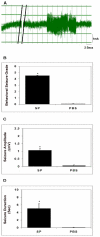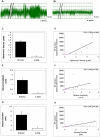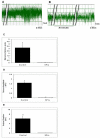Substance P causes seizures in neurocysticercosis
- PMID: 22346746
- PMCID: PMC3276565
- DOI: 10.1371/journal.ppat.1002489
Substance P causes seizures in neurocysticercosis
Abstract
Neurocysticercosis (NCC), a helminth infection of the brain, is a major cause of seizures. The mediators responsible for seizures in NCC are unknown, and their management remains controversial. Substance P (SP) is a neuropeptide produced by neurons, endothelial cells and immunocytes. The current studies examined the hypothesis that SP mediates seizures in NCC. We demonstrated by immunostaining that 5 of 5 brain biopsies from NCC patients contained substance P (SP)-positive (+) cells adjacent to but not distant from degenerating worms; no SP+ cells were detected in uninfected brains. In a rodent model of NCC, seizures were induced after intrahippocampal injection of SP alone or after injection of extracts of cysticercosis granuloma obtained from infected wild type (WT), but not from infected SP precursor-deficient mice. Seizure activity correlated with SP levels within WT granuloma extracts and was prevented by intrahippocampal pre-injection of SP receptor antagonist. Furthermore, extracts of granulomas from WT mice caused seizures when injected into the hippocampus of WT mice, but not when injected into SP receptor (NK1R) deficient mice. These findings indicate that SP causes seizures in NCC, and, suggests that seizures in NCC in humans may be prevented and/or treated with SP-receptor antagonists.
Conflict of interest statement
The authors have declared that no competing interests exist.
Figures





Similar articles
-
Absence of the SP/SP receptor circuitry in the substance P-precursor knockout mice or SP receptor, neurokinin (NK)1 knockout mice leads to an inhibited cytokine response in granulomas associated with murine Taenia crassiceps infection.J Parasitol. 2008 Dec;94(6):1253-8. doi: 10.1645/GE-1481.1. J Parasitol. 2008. PMID: 18576810 Free PMC article.
-
Substance P signaling contributes to granuloma formation in Taenia crassiceps infection, a murine model of cysticercosis.J Biomed Biotechnol. 2010;2010:597086. doi: 10.1155/2010/597086. Epub 2010 Jan 28. J Biomed Biotechnol. 2010. PMID: 20150970 Free PMC article.
-
Epileptogenic activity of granulomas associated with murine cysticercosis.Exp Neurol. 2003 Oct;183(2):532-6. doi: 10.1016/s0014-4886(03)00179-1. Exp Neurol. 2003. PMID: 14552894
-
Disease Centered Around Calcified Taenia solium Granuloma.Trends Parasitol. 2017 Jan;33(1):65-73. doi: 10.1016/j.pt.2016.09.003. Epub 2016 Oct 4. Trends Parasitol. 2017. PMID: 27720140 Free PMC article. Review.
-
Controversies in the treatment of seizures associated with neurocysticercosis.Epilepsy Behav. 2017 Nov;76:163-167. doi: 10.1016/j.yebeh.2017.05.033. Epub 2017 Jun 30. Epilepsy Behav. 2017. PMID: 28673685 Review.
Cited by
-
Solitary Brain Mass in a Patient with Seizures: An Unexpected Infectious Etiology.Diseases. 2018 Jun 22;6(3):54. doi: 10.3390/diseases6030054. Diseases. 2018. PMID: 29932160 Free PMC article.
-
Granulomas in parasitic diseases: the good and the bad.Parasitol Res. 2020 Oct;119(10):3165-3180. doi: 10.1007/s00436-020-06841-x. Epub 2020 Aug 13. Parasitol Res. 2020. PMID: 32789534 Review.
-
Seizures and Epilepsy in Association With Neurocysticercosis: A Nosologic Proposal.Neurology. 2024 Nov 12;103(9):e209865. doi: 10.1212/WNL.0000000000209865. Epub 2024 Oct 7. Neurology. 2024. PMID: 39374469 Free PMC article.
-
Controlling the Host Response in Neurocysticercosis.Am J Trop Med Hyg. 2019 Mar;100(3):483-484. doi: 10.4269/ajtmh.18-0908. Am J Trop Med Hyg. 2019. PMID: 30608054 Free PMC article. No abstract available.
-
The potential for histone deacetylase (HDAC) inhibitors as cestocidal drugs.PLoS Negl Trop Dis. 2021 Mar 3;15(3):e0009226. doi: 10.1371/journal.pntd.0009226. eCollection 2021 Mar. PLoS Negl Trop Dis. 2021. PMID: 33657105 Free PMC article.
References
-
- Singhi P. Infectious causes of seizures and epilepsy in the developing world. Dev Med Child Neurol. 2011;53:600–609. - PubMed
-
- Shandera WX, Kass JS. Neurocysticercosis: current knowledge and advances. Curr Neurol Neurosci Rep. 2006;6:453–459. - PubMed
-
- Cruz ME, Schantz PM, Cruz I, Espinosa P, Preux PM, et al. Epilepsy and neurocysticercosis in an Andean community. Int J Epidemiol. 1999;28:799–803. - PubMed
-
- Medina MT, Rosas E, Rubio-Donnadieu F, Sotelo J. Neurocysticercosis as the main cause of late-onset epilepsy in Mexico. Arch Intern Med. 1990;150:325–327. - PubMed
-
- White AC., Jr Neurocysticercosis: updates on epidemiology, pathogenesis, diagnosis, and management. Annu Rev Med. 2000;51:187–206. - PubMed
Publication types
MeSH terms
Substances
Grants and funding
LinkOut - more resources
Full Text Sources
Medical
Molecular Biology Databases

